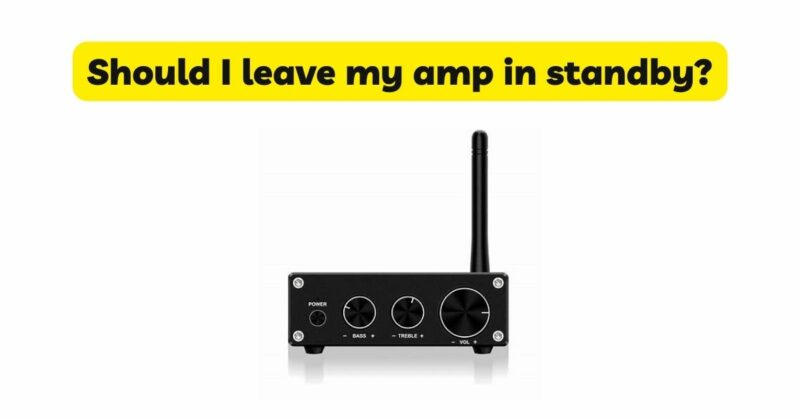Standby mode is a feature found in many amplifiers, providing a low-power state while keeping the device ready for immediate use. The decision of whether to leave your amp in standby mode or power it off completely depends on several factors. This article aims to delve into the pros and cons of leaving an amp in standby mode, helping you make an informed choice about how to handle your amplifier when it’s not in active use.
I. Understanding Standby Mode:
- Functionality: Standby mode is designed to put the amplifier in a state of reduced power consumption while keeping it operational. In this mode, the amplifier remains connected to the power source and is ready to be quickly powered back on when needed.
- Instant Availability: One of the primary advantages of standby mode is that it allows for instant availability. By leaving the amp in standby, you can quickly resume listening to audio without the need for a lengthy power-up sequence.
II. Pros of Leaving Your Amp in Standby:
- Convenience: Standby mode offers the convenience of immediate access to audio. This is particularly useful in situations where you frequently use the amplifier or require instant availability for audio playback.
- Energy Efficiency: When in standby mode, amplifiers consume significantly less power compared to their active state. By leaving your amp in standby, you can conserve energy and contribute to a more environmentally friendly and cost-effective operation.
- Extended Lifespan: Powering up an amplifier can subject its internal components to stress, especially during the initial surge of electrical current. Leaving the amp in standby mode reduces the frequency of power cycles, potentially prolonging the lifespan of certain components.
III. Cons of Leaving Your Amp in Standby:
- Cumulative Energy Consumption: Although standby mode reduces power consumption, the amp still draws a small amount of power to maintain readiness. If left in standby for extended periods, the cumulative energy consumption can become significant, especially if the amplifier is not being used frequently.
- Component Wear and Tear: Leaving the amp in standby mode for prolonged durations can contribute to wear and tear on certain components. While reduced, the flow of electricity can still have an impact on the longevity of components such as capacitors and transistors.
- Heat Generation: Even in standby mode, some heat is generated by the amplifier due to the presence of low-power circuitry. If the amp is placed in an enclosed space or lacks proper ventilation, this residual heat can accumulate, potentially affecting the device’s performance or causing overheating issues.
- Power Surge Vulnerability: Amplifiers left in standby mode remain connected to the power source, making them susceptible to power surges or electrical disturbances. While most modern amps have built-in protection mechanisms, a significant power surge could still potentially damage the device.
IV. Considerations for Choosing Standby Mode:
- Usage Patterns: Consider your usage patterns and how frequently you use the amplifier. If you frequently need immediate access to audio, leaving the amp in standby may be more practical. However, if long periods of inactivity are expected, powering off the amp completely may be a more energy-efficient choice.
- Energy Efficiency: Evaluate your energy consumption priorities. If energy conservation is a significant concern, using standby mode can help reduce power consumption during periods of inactivity. However, if standby mode is being utilized without regular use, the energy savings may be less significant.
- Ventilation and Cooling: Ensure that the amplifier has proper ventilation, even when in standby mode. Adequate airflow helps dissipate any residual heat generated by the low-power circuitry, reducing the risk of overheating and maintaining optimal performance.
- External Factors: Consider environmental factors such as ambient temperature and humidity. Extreme temperatures or high humidity can impact the longevity and performance of amplifiers. If the environment poses risks, powering off the amp completely might be a safer option.
Conclusion:
The decision of whether to leave your amp in standby mode or power it off completely depends on your specific needs, usage patterns, and energy conservation priorities. Standby mode offers the convenience of instant availability and energy efficiency but can lead to cumulative energy consumption and potential component wear and tear. Consider factors such as usage frequency, energy efficiency goals, ventilation, and external environmental conditions when making your decision. Striking a balance between convenience, energy efficiency, and the longevity of your amplifier will ensure optimal performance and satisfaction with your audio system.


